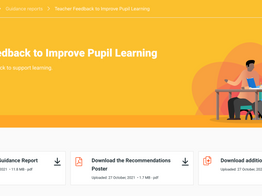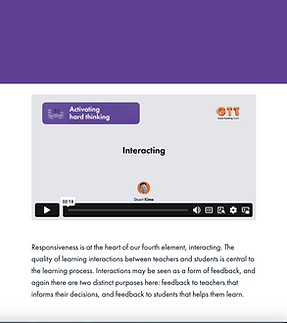Overview

Feedback informs a student and/or teacher about the student’s performance relative to learning goals.
Feedback redirects or refocuses teacher and student actions so the student can align effort and activity with a clear outcome that leads to achieving a learning goal.
Teachers and peers can provide formal or informal feedback. It can be oral, written, formative or summative. Whatever its form, it comprises specific advice a student can use to improve performance.
Key Elements
-
Precise, timely, specific, accurate and actionable
-
Questioning and assessment is feedback on teaching practice
-
Use student voice to enable student feedback about teaching

Related Effect Sizes
Feedback – 0.73
This strategy is demonstrated when the teacher:
Provides feedback on tasks that challenges students to review, reflect on and refine their understandings at various points in a learning sequence
Gives timely feedback, acknowledging areas well-handled and suggesting areas for improvement
Structures feedback to support further learning
Organises a variety of audiences to provide feedback
Uses student assessment data as a source of feedback on the effectiveness of their teaching practice.
This strategy is NOT demonstrated when the teacher:
Provides feedback that is about the person (such as, ‘you are my best student’) or vague (such as, ‘good job’)
Only provides feedback about students’ performance in formal, summative assessment situations, without the opportunity for students to refine and develop understandings on the basis of instructive feedback.
This strategy is demonstrated when students:
Understand what they need to do to improve.
Feel encouraged and supported to achieve the learning goals.
Use feedback to monitor and self-regulate their learning.
Typical problems of practice in this area:
Feedback is often delayed, reducing its relevance and impact on student learning.
Feedback lacks clarity and actionable steps, leaving students unsure of how to improve.
Feedback is disconnected from learning goals or success criteria, failing to guide students meaningfully.
Feedback is overly reliant on one medium, such as written comments, and lacks diversity or interaction.
Feedback delivered inappropriately can demotivate students or discourage a growth mindset.
Students do not read, understand, or act on the feedback provided.
The feedback is generic and not personalized to individual student needs or contexts.
Possible LfL questions to ask students
How does your teacher give you feedback?
What do you do with the feedback you get from your teacher?
How quickly does your teacher give feedback after the task has been submitted?
Do you understand the feedback you get?
What type of feedback do you find is most useful to you?
-
Learners experience supportive, respectful, and authentic relationships
-
Learners thrive in an environment that is both safe and challenging
-
Learners understand the purpose of their learning
-
Learners readily connect new learning with previous knowledge, concepts and skills
-
Learners feel individually challenged at an appropriate level
-
Learners have increasing agency in their learning
-
Learners receive ongoing feedback
-
Learners experience a range of learning and teaching methodologies
-
Learners have ample opportunities to practise
-
Learners have regular opportunities to collaborate with and learn from others
Reminder of the TLPP

Training Materials from GTT (Great Teaching Toolkit)
How the Great Teaching Toolkit supports this HIT
Element 2.3 Learner motivation (See article “UCL verbal feedback report”)
Element 4.3 Questioning (See article “How to integrate effective feedback into your classroom”)
Element 4.4 Interacting (See article “The feedback pendulum”)
Element 4.4 Interacting (See article “Reducing teacher workload: the re-balancing feedback trial report”)





















